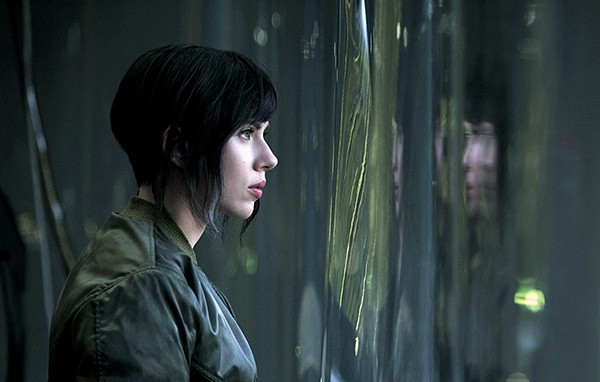Did Blade Runner see the future, or does the future just want to look like Blade Runner? Ridley Scott’s 1982 adaptation was a flop at the time, but its imagery, particularly its dark cityscapes and culturally hybrid inhabitants, have been reimagined time and again. Did Scott have a vision of the future, or is it just that industrial designers and sci-fi movie art directors loved his movie and wanted to emulate it?
My guess is it’s a little bit of both. One of the earliest Blade Runner emulators was the manga Ghost in the Shell by Masamune Shirow, which told the story of Section 9, an elite counterterrorism task force operating in a fictional Japanese city of the near future. Prosthetic technology and mind-machine interfaces blurred the lines between human and robot. The members of the team all fall along a spectrum of cybernetic enhancement, from Togusa, who is completely human, to Major Motoko Kusanagi, who is basically a human brain inside a robot body.
Ghost in the Shell‘s 1995 animated feature film adaptation was a big hit in Japan and proved to be hugely influential to Western filmmakers, particularly the Wachowskis. The cascade of green computer code in The Matrix; Neo and Trinity’s mixture of l33t skillz, kung fu, and extreme gunplay; as well as their generally flat emotional aspect were all mainlined from Ghost in the Shell. Batman may have lurked on rooftops for decades, but when the camera swooped around Christian Bale diving from a Hong Kong skyscraper in Batman Begins, Christopher Nolan was channeling Major Kusanagi’s emotionless leap of faith.

Scarlett Johansson is Motoko Kusanagi in the new, live-action Ghost in the Shell.
The franchise spawned several big-screen sequels of diminishing returns and a much more rewarding anime series, Stand Alone Complex, which got a lot of airplay on American TV. Ghost in the Shell began as an ensemble piece, but Major Kusanagi quickly emerged as the lead character. For one thing, she’s a walking, talking, gun-toting existential crisis. For another thing, when the Major wears her adaptive camo outfit, she kinda looks like she’s naked.
Ghost in the Shell’s $110 million live-action adaptation turns out to be a solution in search of a problem. First, there already was a live-action adaptation of this material: It was called The Matrix. Second, the casting of New Yorker Scarlett Johansson as the Japanese cyborg Motoko Kusanagi caused a backlash amongst the net-savvy target audience who are currently consumed with questions of identity. Critics saw this as yet another case of whitewashing, where Asian actors are passed over in favor of Caucasians (See: Mickey Rooney’s cringeworthy appearance in Breakfast at Tiffany’s).
The irony is, Ghost in the Shell has always been obsessed with identity; it’s just a different kind of identity. The Major is a living example of Plutarch’s Ship of Theseus. If you gradually replace and repair every part of a ship, is it still the same ship? How much of Motoko Kusanagi can you replace with superior cybernetics before she ceases to be human? If, like the antagonist known as Kuze (Michael Pitt), you could upload your consciousness into multiple bodies at once, are you still a single individual? If you can hook your brain into the net, your brain can be hacked. If your behavior is controlled by someone else, are you responsible for your actions? Before the Major was a cyborg, she was a lesbian. What use does a robot have for sexuality? What if you found out your memories are fake, implanted by someone trying to manipulate you?
Whitewashing or not, Johansson is terrific as the Major. Her body language reads as a confident swagger, but it gradually becomes clear that it’s her cybernetic body executing an awkward walk-loop subroutine. Like Leonard Nimoy, she can wring pathos out of near emotionlessness.
Unfortunately, to appreciate her performance, you’d have to be paying attention. This version of Ghost in the Shell shares the franchise’s Achilles’ heel: Despite the fascinating ideas swirling in the background, the foreground can be deathly dull. The urban gun-fu that seemed so fresh in the 1990s is old hat now, and the John Wick crowd is just not going to sit still for the sci-fi politics and transhumanist philosophy.
The producers could have spent half as much money making a state-of-the-art anime Ghost in the Shell reboot that played up the material’s strengths and avoided the identity politics trap they blundered into. Like Disney’s live-action adaptations of its animated classics, this film is frequently beautiful but utterly fails to justify its existence.